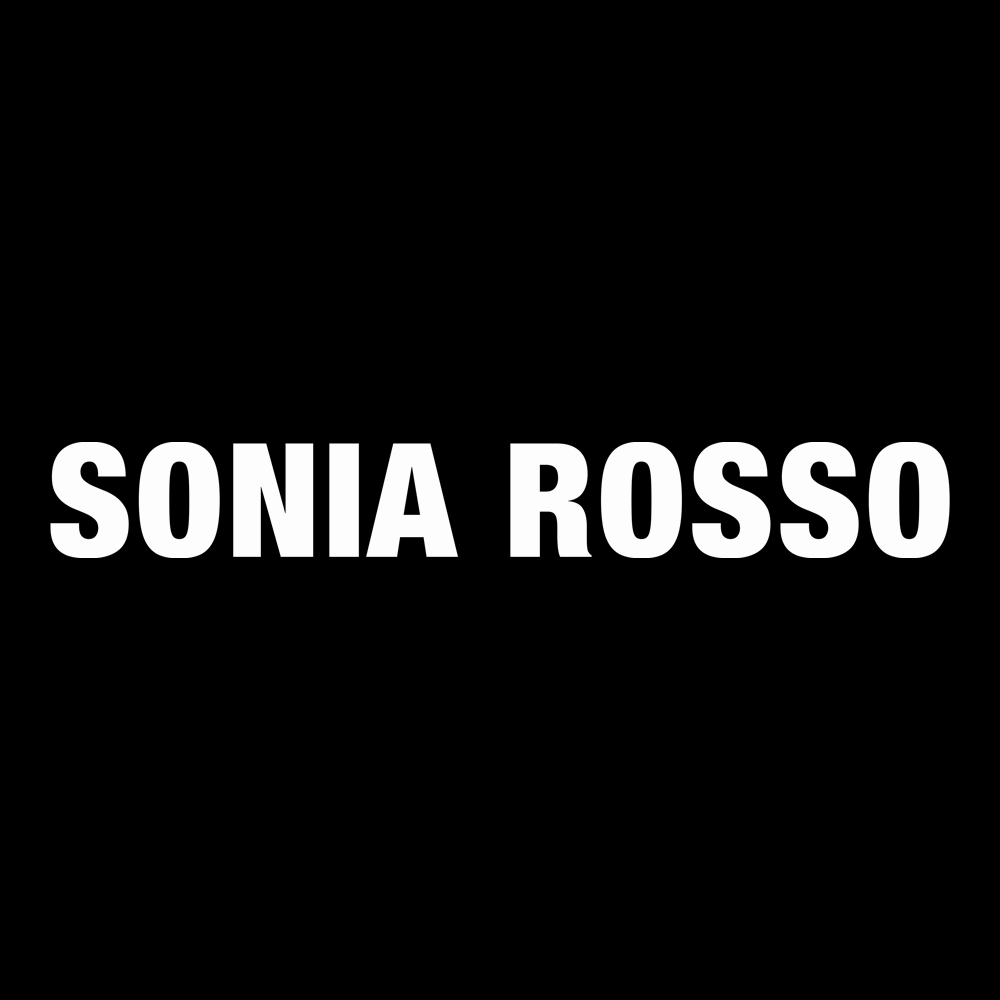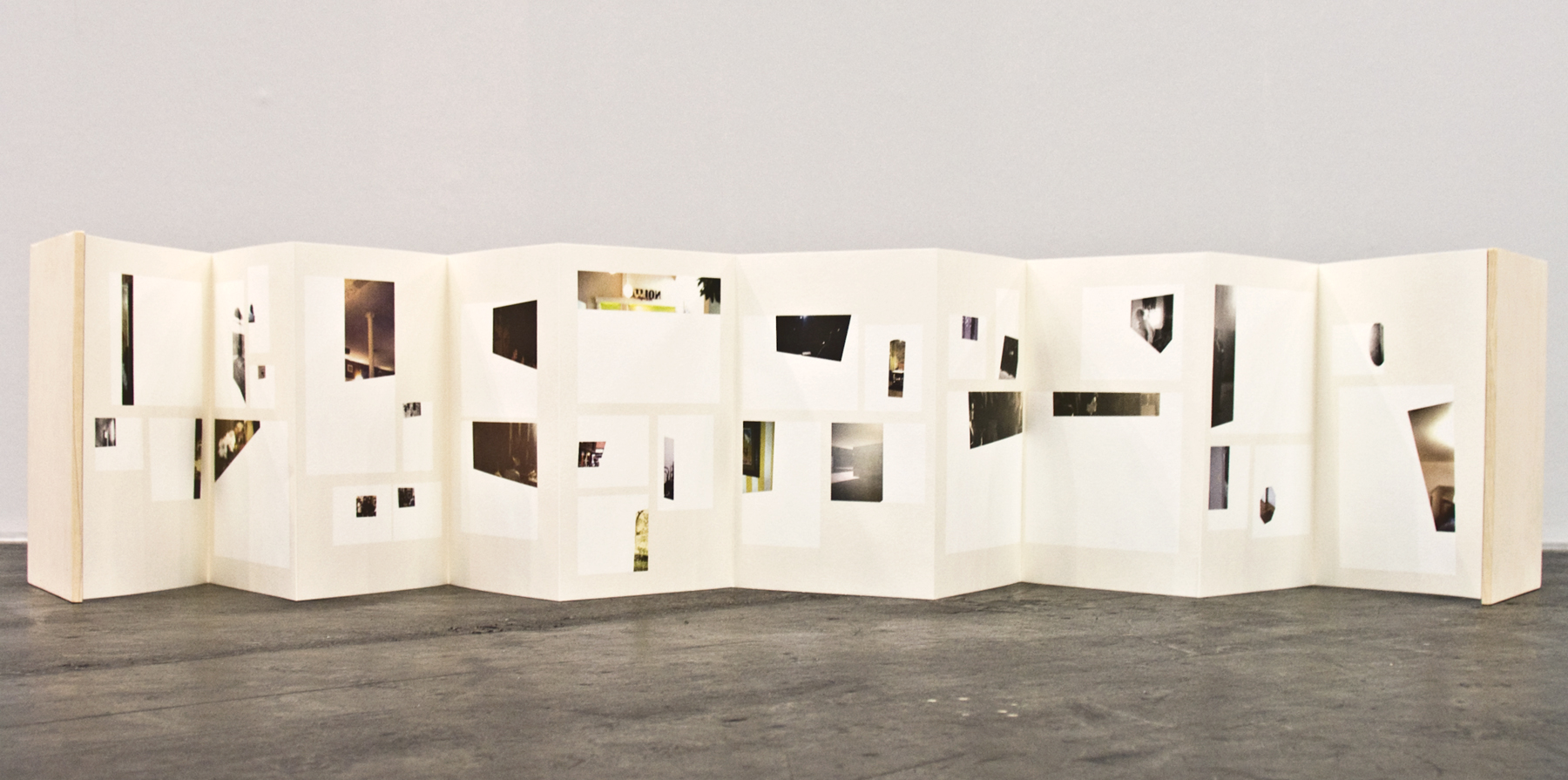


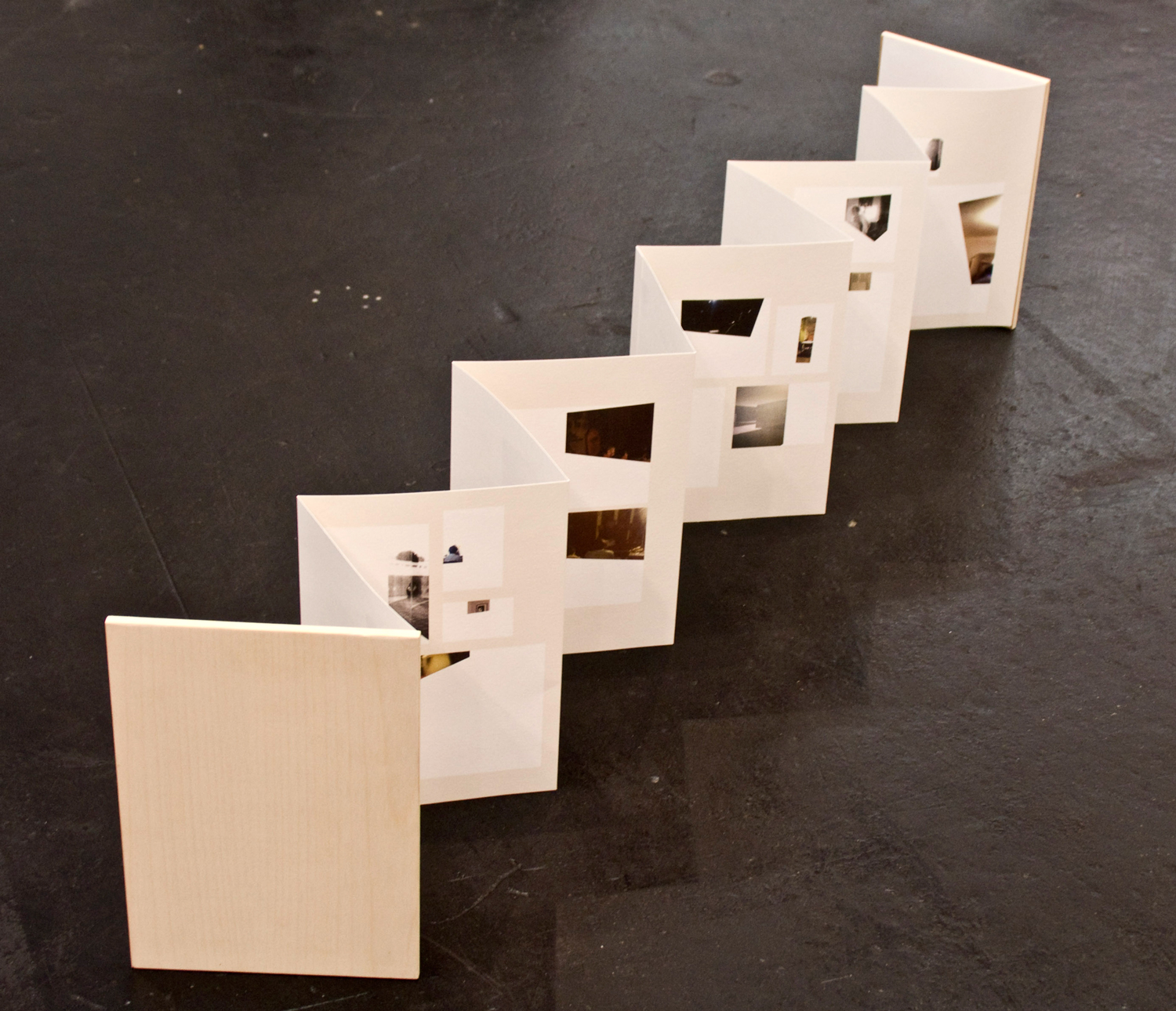
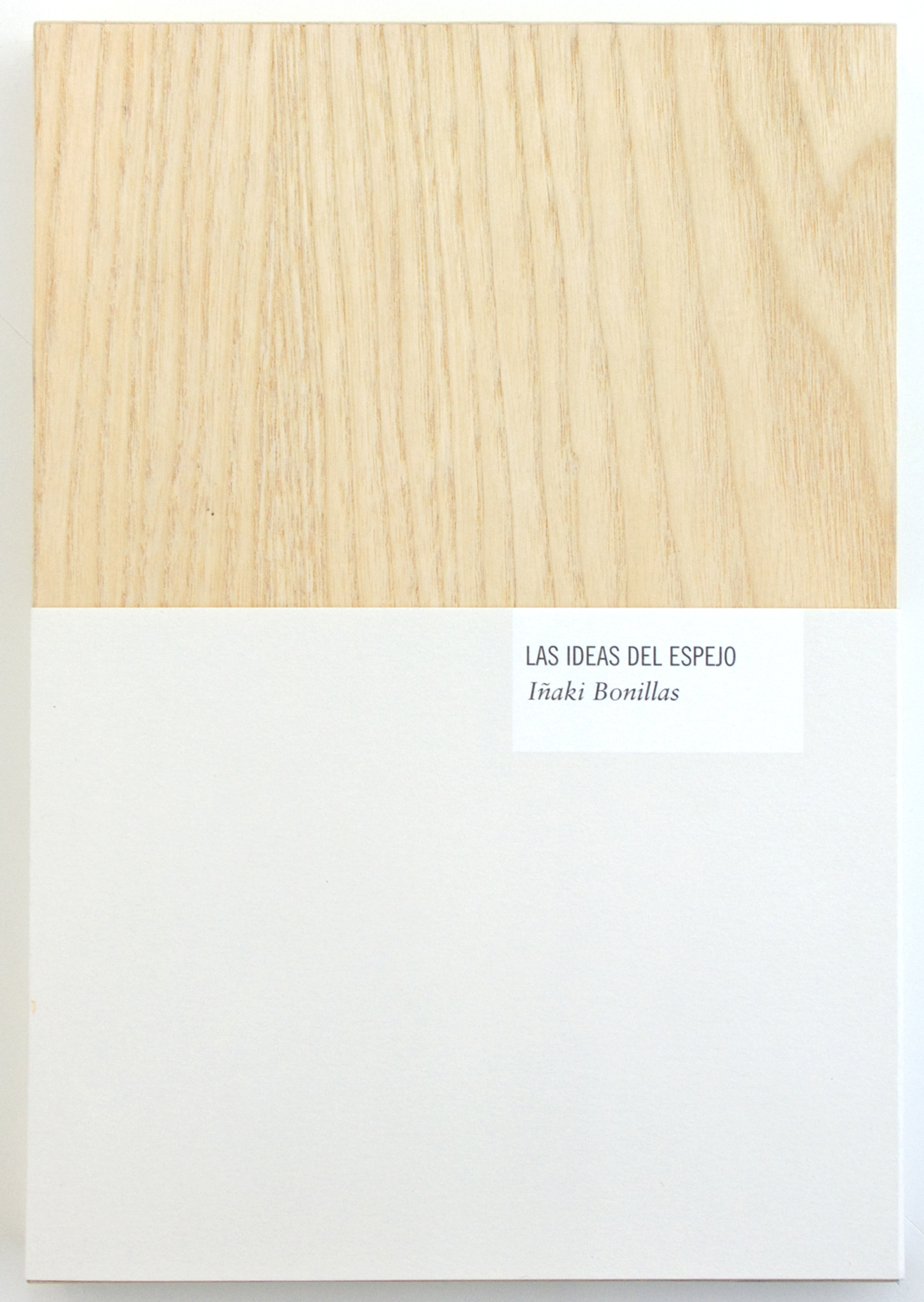
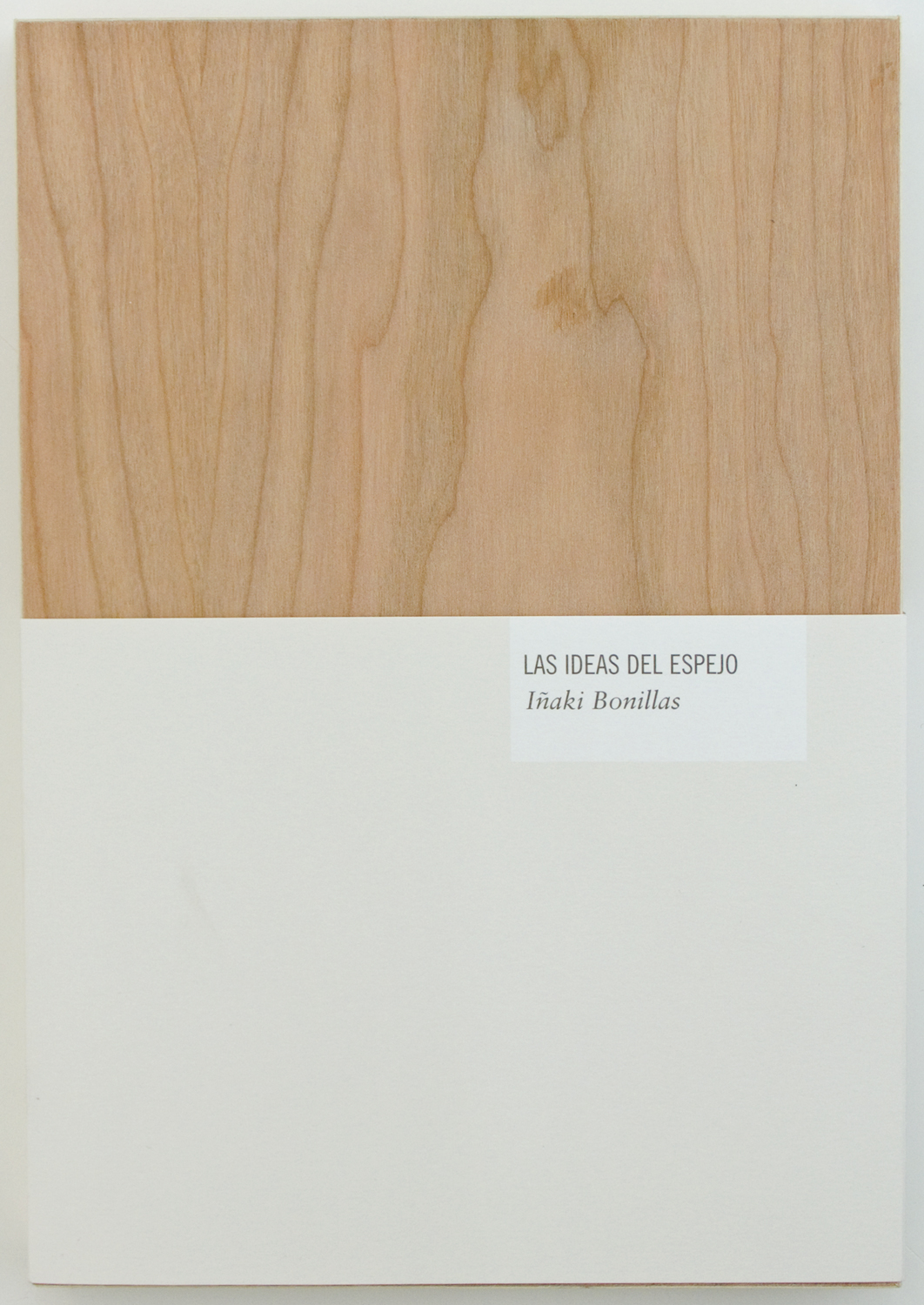
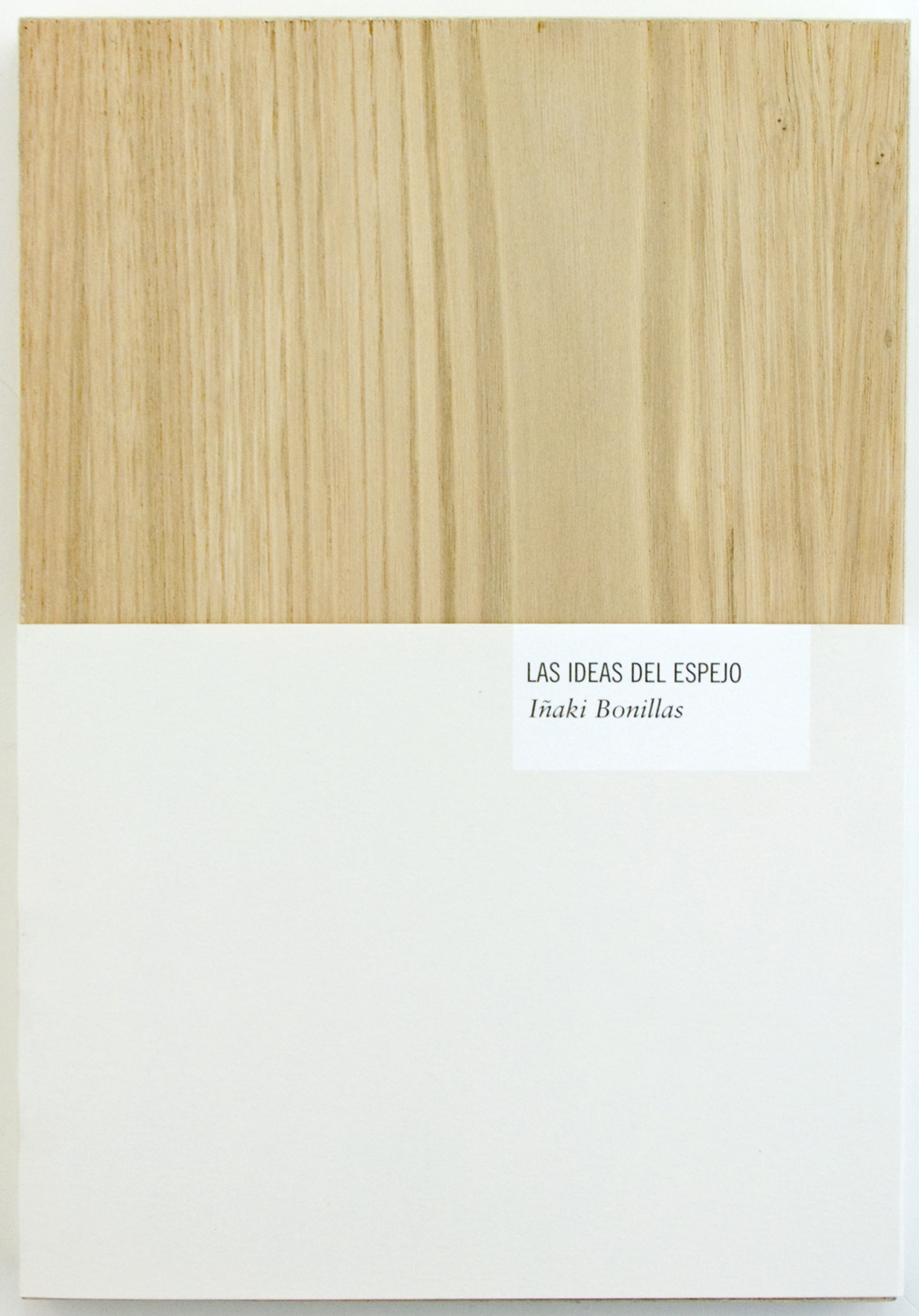
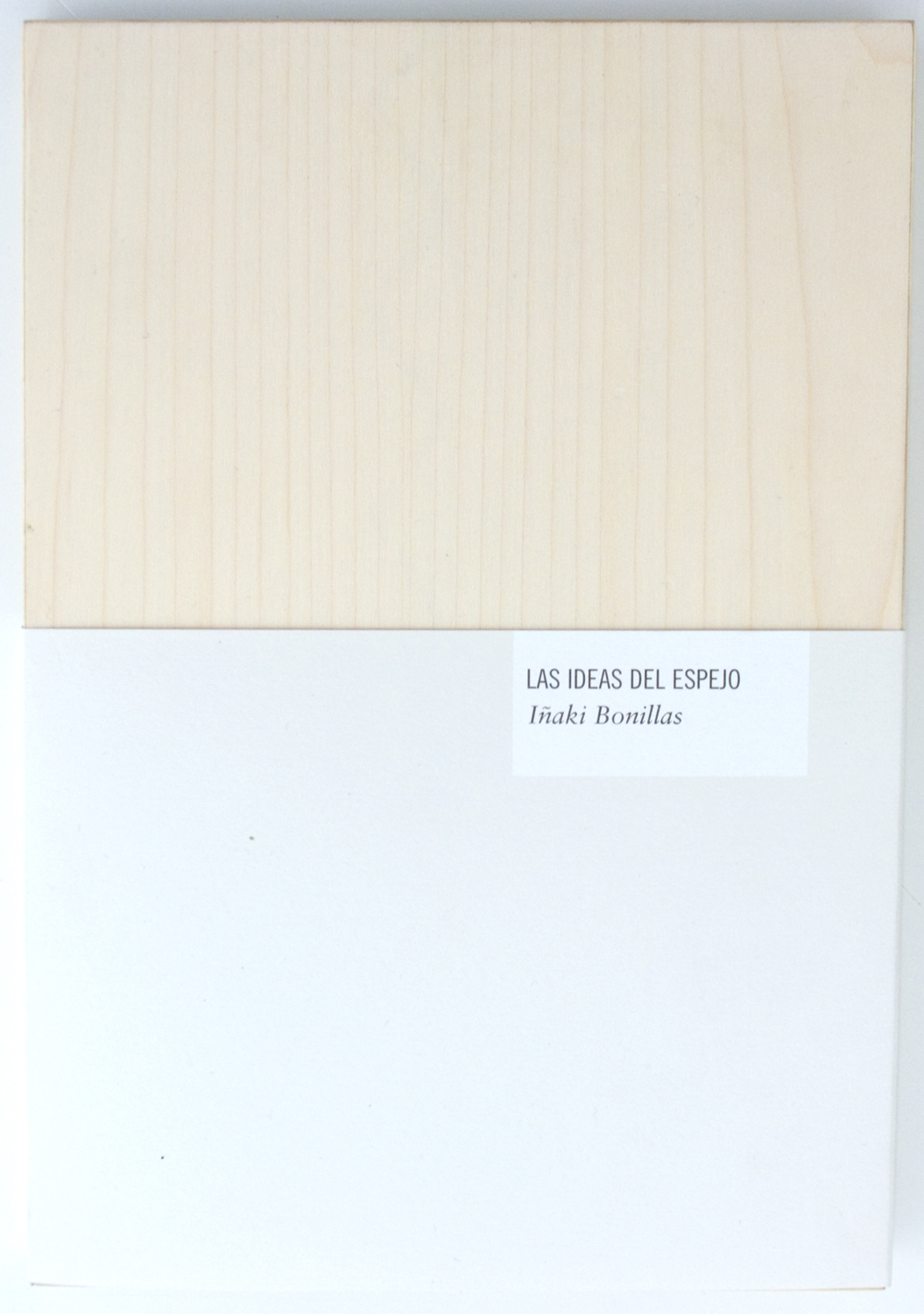
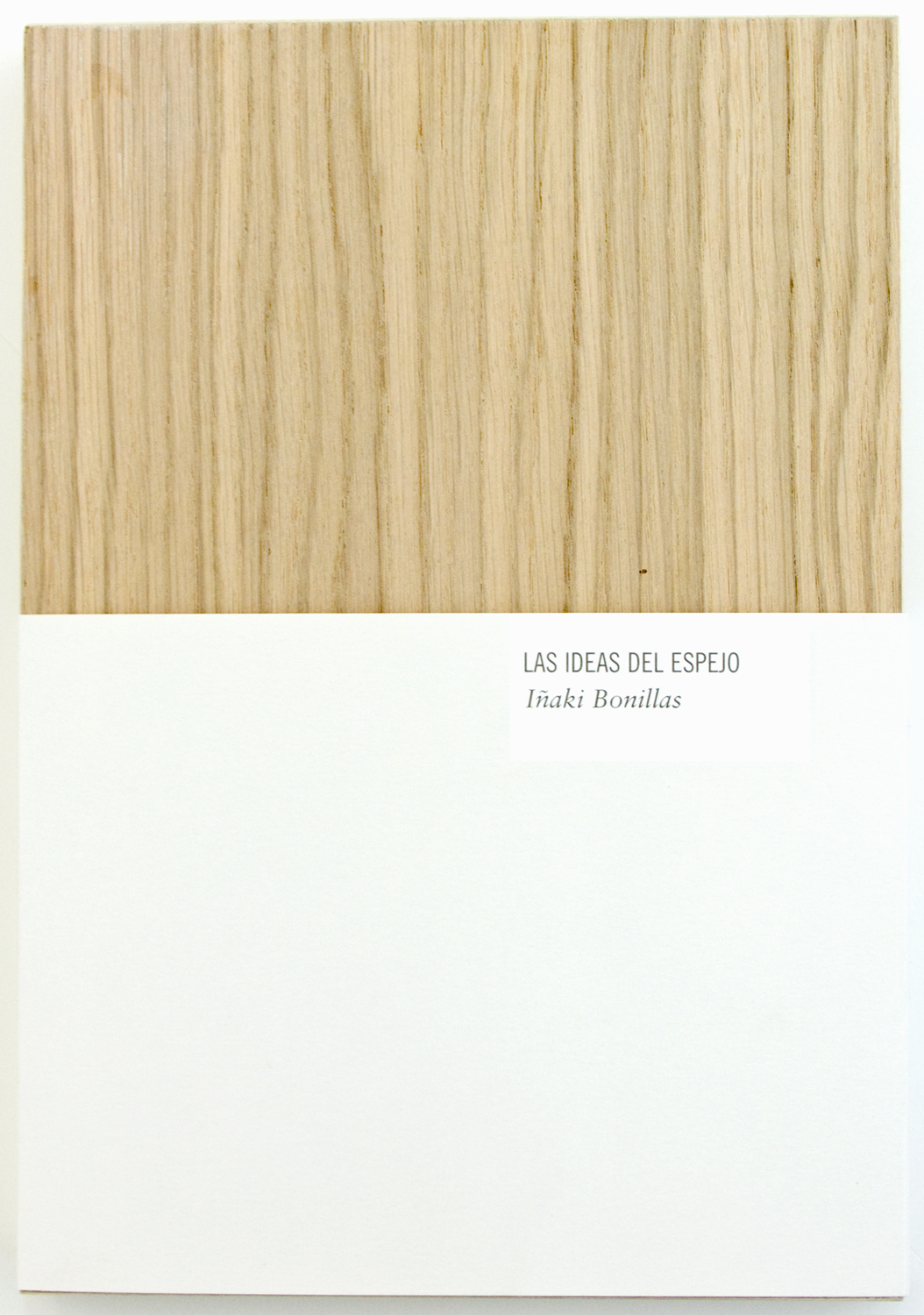
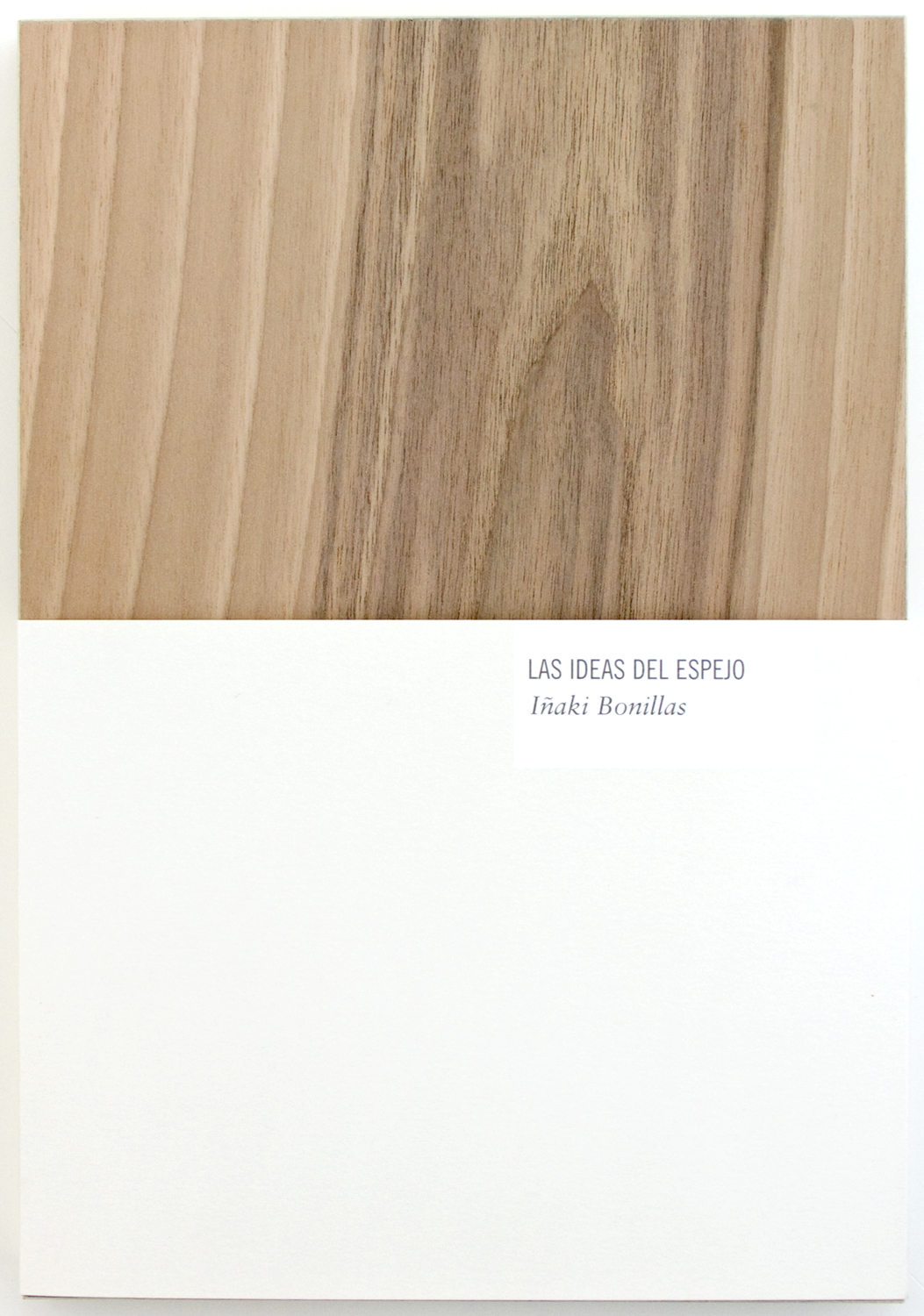

Iñaki Bonillas
Las ideas del espejo, 2010
artist's book
20 x 28,5 cm, 10 pages offset print on old mill Fabriano paper
edition of 60 + 12 AP, in 6 versions of different wood, ten for each
produced by THE BINDING, Turin and published by Silvio Zamorani Editore, Turin
For the Project THE BINDING, Iñaki Bonillas decided to make a leporello, called Las ideas del espejo.
The cover of the book has been made in 6 different quality of wood - oak, maple, ash, chestnut, cherry and walnut-, ten copies for each quality for a total of an edition of 60 + 12 ap. The photos are printed in offset on old mill Fabriano paper (mg 250, 10 pages); the book has been held out by eight magnets placed on the four corners of the two wood’s covers and the size of the book is cm 20 x 20,8. The colophone is on the back and the book is signed and numbered. Inside there is a text by the artist. The book was produced by THE BINDING, Turin and published by Silvio Zamorani Editore, Turin
Per il Progetto THE BINDING, Iñaki Bonillas ha deciso di realizzare un leporello, intitolato Las ideas del espejo
La copertina del libro è stata realizzata in 6 diverse qualità di legno - quercia, acero, frassino, castagno, ciliegio e noce -, dieci copie per ogni qualità per un totale di un'edizione di 60 + 12 ap. Le foto sono stampate in offset su carta Fabriano old mill (mg 250, 10 pagine); il libro è tenuto insieme da otto magneti posti ai quattro angoli delle due copertine di legno e la dimensione del libro è di cm 20 x 20,8. Il colofone è sul retro. Il libro è firmato e numerato. All'interno c'è un testo dell'artista. Il libro è stato prodotto da THE BINDING, Torino e pubblicato da Silvio Zamorani Editore, Torino
“There is no object which fulfils its function more diligently than a mirror, and none more reliable: the image it reflects (of ourselves and of the world) is the most exact copy that can ever exist. More than that: the specular reflection is perhaps the only possibility of the truly identical, of the absolute unfolding – it is not fortuitous that the word reflection includes in its Latin origin the sense of “a bending back”.
How many times, however, have we felt, to our utter restlessness, that the mirror does not reveal the truth but instead it modifies it, ever so slightly: Is this how I look? In fact –and because the mirror will always show us images in reverse–, we have to say that there is no perfect mirror simply because physics doesn’t allow it: the tinniest curvature on its surface can seriously alter what we see. Jean Cocteau was fond of saying that mirrors should think very carefully before reflecting images (which are not always the ones we want to see).
But who is to say that they do not: maybe mirrors have their own ideas about the world (after all, they are devoted to contemplation), and from time to time, they decide to take a few… how to call them? poetic licenses? It might seem so to us when, for example, in a photograph, a mirror is accidentally included in the shot, whose reflection give us the impression of being visually independent of the rest of the picture. Thus, in the middle of a scene, let us say, a family scene, suddenly a void opens up, one that seems intent on stealing the shot, on taking the gaze to some other place, otherwise invisible: the garden for example; the painting that decorates the “fourth wall” (the one that in theater is occupied by the spectators); the photographer’s shadow; the revealing look in the lover’s eyes, etc. That condition of something being at once inside and, rebelliously, outside the frame is what inspires the series, “Las ideas del espejo”: an approach to those photographic images that randomly emerge—by the mirror’s will—from within an original shot (the one intended by the author). Its purpose is, then, to create an archive from these pictures that no one really shot, but are in there nonetheless” (Iñaki Bonillas, 2010).
Las ideas del espejo, 2010
“Non c’è oggetto che compia la sua funzione più diligentemente di uno specchio, e nessuno più affidabile: l’immagine riflessa (di noi stessi e del mondo) è la copia più esatta che possa mai esistere. Il riflesso speculare è forse la sola possibilità di una vera identità e di un dispiegarsi assoluto -non è un caso che la parola riflesso includa nella sua origine latina il senso di “piegarsi”. Quante volte, abbiamo provato, con una certa agitazione, che lo specchio non rivela la verità ma invece la modifica, anche se leggermente: è così che appaio? Infatti -poichè lo specchio ci mostrerà sempre le immagini al rovescio-, dobbiamo convenire che non c’è specchio perfetto semplicemente perché la fisica non lo permette: la più sottile curvatura sulla sua superficie può seriamente alterare ciò che vediamo. Jean Cocteau usava dire che gli specchi dovrebbero pensare molto attentamente prima di riflettere le immagini (che non sempre sono quelle che vogliamo vedere). Ma chi può sostenere che non lo facciano: forse gli specchi hanno le loro idee riguardo al mondo (dopo tutto, essi sono devoti alla contemplazione), e di tanto in tanto, essi decidono di prendersi delle…come possiamo chiamarle? Licenze poetiche? Potrebbe sembrarci così quando, per esempio, in una fotografia, uno specchio è accidentalmente incluso nello scatto e il suo riflesso ci da l’impressione di essere visivamente indipendente dal resto della fotografia. Così, nel mezzo di una scena, diciamo, una scena familiare, improvvisamente si apre un vuoto che sembra voler rubare lo scatto, portando lo sguardo da un’altra parte che altrimenti non sarebbe visibile: il giardino per esempio, il quadro che decora “Ia quarta parete” (quella che nel teatro è occupata dagli spettatori); l’ombra del fotografo; lo sguardo rivelatore negli occhi dell’amante, etc. Questa condizione di qualcosa che, ribellandosi, si situa allo stesso tempo dentro e fuori dalla cornice è ciò che ispira la serie, Las ideas del espejo: un approccio a quelle immagini fotografiche che, grazie al volere dello specchio, si rivelano per caso all’interno dello scatto originario (quello concepito dall’autore). Il proposito è, quindi, il creare un archivio di quelle immagini che nessuno ha veramente fotografato, ma che tuttavia esistono” (Iñaki Bonillas, 2010).

Iñaki Bonillas
Las ideas del espejo, 2010
artist's book
20 x 28,5 cm, 10 pages offset print on old mill Fabriano paper
edition of 60 + 12 AP, in 6 versions of different wood, ten for each
produced by THE BINDING, Turin and published by Silvio Zamorani Editore, Turin
For the Project THE BINDING, Iñaki Bonillas decided to make a leporello, called Las ideas del espejo.
The cover of the book has been made in 6 different quality of wood - oak, maple, ash, chestnut, cherry and walnut-, ten copies for each quality for a total of an edition of 60 + 12 ap. The photos are printed in offset on old mill Fabriano paper (mg 250, 10 pages); the book has been held out by eight magnets placed on the four corners of the two wood’s covers and the size of the book is cm 20 x 20,8. The colophone is on the back and the book is signed and numbered. Inside there is a text by the artist. The book was produced by THE BINDING, Turin and published by Silvio Zamorani Editore, Turin
Per il Progetto THE BINDING, Iñaki Bonillas ha deciso di realizzare un leporello, intitolato Las ideas del espejo
La copertina del libro è stata realizzata in 6 diverse qualità di legno - quercia, acero, frassino, castagno, ciliegio e noce -, dieci copie per ogni qualità per un totale di un'edizione di 60 + 12 ap. Le foto sono stampate in offset su carta Fabriano old mill (mg 250, 10 pagine); il libro è tenuto insieme da otto magneti posti ai quattro angoli delle due copertine di legno e la dimensione del libro è di cm 20 x 20,8. Il colofone è sul retro. Il libro è firmato e numerato. All'interno c'è un testo dell'artista. Il libro è stato prodotto da THE BINDING, Torino e pubblicato da Silvio Zamorani Editore, Torino
“There is no object which fulfils its function more diligently than a mirror, and none more reliable: the image it reflects (of ourselves and of the world) is the most exact copy that can ever exist. More than that: the specular reflection is perhaps the only possibility of the truly identical, of the absolute unfolding – it is not fortuitous that the word reflection includes in its Latin origin the sense of “a bending back”.
How many times, however, have we felt, to our utter restlessness, that the mirror does not reveal the truth but instead it modifies it, ever so slightly: Is this how I look? In fact –and because the mirror will always show us images in reverse–, we have to say that there is no perfect mirror simply because physics doesn’t allow it: the tinniest curvature on its surface can seriously alter what we see. Jean Cocteau was fond of saying that mirrors should think very carefully before reflecting images (which are not always the ones we want to see).
But who is to say that they do not: maybe mirrors have their own ideas about the world (after all, they are devoted to contemplation), and from time to time, they decide to take a few… how to call them? poetic licenses? It might seem so to us when, for example, in a photograph, a mirror is accidentally included in the shot, whose reflection give us the impression of being visually independent of the rest of the picture. Thus, in the middle of a scene, let us say, a family scene, suddenly a void opens up, one that seems intent on stealing the shot, on taking the gaze to some other place, otherwise invisible: the garden for example; the painting that decorates the “fourth wall” (the one that in theater is occupied by the spectators); the photographer’s shadow; the revealing look in the lover’s eyes, etc. That condition of something being at once inside and, rebelliously, outside the frame is what inspires the series, “Las ideas del espejo”: an approach to those photographic images that randomly emerge—by the mirror’s will—from within an original shot (the one intended by the author). Its purpose is, then, to create an archive from these pictures that no one really shot, but are in there nonetheless” (Iñaki Bonillas, 2010).
Las ideas del espejo, 2010
“Non c’è oggetto che compia la sua funzione più diligentemente di uno specchio, e nessuno più affidabile: l’immagine riflessa (di noi stessi e del mondo) è la copia più esatta che possa mai esistere. Il riflesso speculare è forse la sola possibilità di una vera identità e di un dispiegarsi assoluto -non è un caso che la parola riflesso includa nella sua origine latina il senso di “piegarsi”. Quante volte, abbiamo provato, con una certa agitazione, che lo specchio non rivela la verità ma invece la modifica, anche se leggermente: è così che appaio? Infatti -poichè lo specchio ci mostrerà sempre le immagini al rovescio-, dobbiamo convenire che non c’è specchio perfetto semplicemente perché la fisica non lo permette: la più sottile curvatura sulla sua superficie può seriamente alterare ciò che vediamo. Jean Cocteau usava dire che gli specchi dovrebbero pensare molto attentamente prima di riflettere le immagini (che non sempre sono quelle che vogliamo vedere). Ma chi può sostenere che non lo facciano: forse gli specchi hanno le loro idee riguardo al mondo (dopo tutto, essi sono devoti alla contemplazione), e di tanto in tanto, essi decidono di prendersi delle…come possiamo chiamarle? Licenze poetiche? Potrebbe sembrarci così quando, per esempio, in una fotografia, uno specchio è accidentalmente incluso nello scatto e il suo riflesso ci da l’impressione di essere visivamente indipendente dal resto della fotografia. Così, nel mezzo di una scena, diciamo, una scena familiare, improvvisamente si apre un vuoto che sembra voler rubare lo scatto, portando lo sguardo da un’altra parte che altrimenti non sarebbe visibile: il giardino per esempio, il quadro che decora “Ia quarta parete” (quella che nel teatro è occupata dagli spettatori); l’ombra del fotografo; lo sguardo rivelatore negli occhi dell’amante, etc. Questa condizione di qualcosa che, ribellandosi, si situa allo stesso tempo dentro e fuori dalla cornice è ciò che ispira la serie, Las ideas del espejo: un approccio a quelle immagini fotografiche che, grazie al volere dello specchio, si rivelano per caso all’interno dello scatto originario (quello concepito dall’autore). Il proposito è, quindi, il creare un archivio di quelle immagini che nessuno ha veramente fotografato, ma che tuttavia esistono” (Iñaki Bonillas, 2010).

Iñaki Bonillas
Las ideas del espejo, 2010 (ash)
artist's book
20 x 28,5 cm, 10 pages offset print on old mill Fabriano paper
edition of 60 + 12 AP, in 6 versions of different wood, ten for each
produced by THE BINDING, Turin and published by Silvio Zamorani Editore, Turin

Iñaki Bonillas
Las ideas del espejo, 2010 (cherry)
artist's book
20 x 28,5 cm, 10 pages offset print on old mill Fabriano paper
edition of 60 + 12 AP, in 6 versions of different wood, ten for each
produced by THE BINDING, Turin and published by Silvio Zamorani Editore, Turi

Iñaki Bonillas
Las ideas del espejo, 2010 (chestnut)
artist's book
20 x 28,5 cm, 10 pages offset print on old mill Fabriano paper
edition of 60 + 12 AP, in 6 versions of different wood, ten for each
produced by THE BINDING, Turin and published by Silvio Zamorani Editore, Turin

Iñaki Bonillas
Las ideas del espejo, 2010 (maple)
artist's book
20 x 28,5 cm, 10 pages offset print on old mill Fabriano paper
edition of 60 + 12 AP, in 6 versions of different wood, ten for each
produced by THE BINDING, Turin and published by Silvio Zamorani Editore, Turin

Iñaki Bonillas
Las ideas del espejo, 2010 (oak)
artist's book
20 x 28,5 cm, 10 pages offset print on old mill Fabriano paper
edition of 60 + 12 AP, in 6 versions of different wood, ten for each
produced by THE BINDING, Turin and published by Silvio Zamorani Editore, Turin

Iñaki Bonillas
Las ideas del espejo, 2010 (walnut)
artist's book
20 x 28,5 cm, 10 pages offset print on old mill Fabriano paper
edition of 60 + 12 AP, in 6 versions of different wood, ten for each
produced by THE BINDING, Turin and published by Silvio Zamorani Editore, Turin
